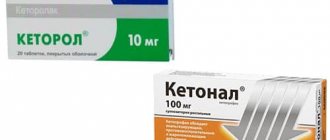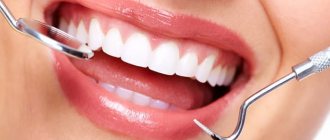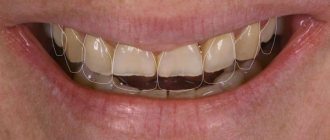Composition and release form
Ketorol is available in two pharmacological forms - tablets and injections. The active ingredient in its composition is ketorolac. It has a powerful anti-inflammatory effect and is even used to relieve severe toothaches caused by pulpitis or maxillofacial injuries.
In addition to the active substance, the tablets contain lactose and starch. For people who are allergic to milk protein, it is better to give preference to the drug in the form of injections. The effect of Ketorol in the fight against pain is often equated to the therapeutic effect of narcotic medications. But adverse reactions from its use are observed much less frequently.
When is Ketorol prescribed?
Three main directions of the drug form the indications that become the reason for prescribing Ketorol:
- soft tissue bruises;
- bursitis;
- ligament damage;
- synovitis;
- myalgia of any etiology;
- neuralgia;
- radiculitis;
- rheumatism.
It should be remembered that taking Ketorol is predominantly symptomatic. When pain appears from the list of indications, take the drug. If there is no pain, you do not need to drink Ketorol or use it as a course of injections.
The choice between tablets and injections is made after analyzing several factors:
- if you have stomach diseases, the tablets are contraindicated;
- for persistent vomiting or difficulty swallowing, Ketorol is administered intramuscularly;
- a broken jaw is a reason to make a choice not in favor of pills;
- acute pain from radiculitis is relieved faster after injection;
- menstrual pain is relieved after taking Ketorol tablets;
- in the postoperative period, they also often opt for tablets, especially if intramuscular administration is complicated by the consequences of the operation.
Despite the fact that Ketorol is prescribed as a NSAID, the main indication is pain. When body temperature rises, preference is given to other active ingredients.
Therapeutic effect
Ketorol can only relieve the symptoms of dental diseases, but not treat them. It is only suitable for temporary relief when it is not possible to urgently consult a doctor. Patients who took potent medications for a long time and did not turn to specialists ended up completely losing problem units without the possibility of restoring them using conservative methods.
Ketorol does not cause addiction in the body, unlike other NSAID drugs, but this does not mean that you can exceed its dosage established in the instructions.
It is not advisable to take Ketorol tablets on your own without first consulting a doctor. Any medication can cause unpredictable reactions from the body. This is especially true for people with severe chronic diseases.
Operating principle
The main component of Ketorol has the ability to be absorbed from the intestines into the blood. It quickly penetrates the internal organs and tissues, thereby providing a rapid therapeutic effect. Ketorolac (active ingredient) has the ability to suppress the activity of enzymes that cause the production of prostaglandins. The substances are responsible for the susceptibility of pain, the development of the inflammatory process and an increase in body temperature.
Not all prostaglandins affect the development of the inflammatory process; some of them are necessary to protect the mucous membranes of the stomach from external irritants. 1st generation NSAIDs, which include Ketorol, block all types of hormones, therefore, with long-term use, an exacerbation of gastrointestinal diseases is possible. Because of this, the patient may feel discomfort in the upper abdomen. NSAIDs of the latest generations selectively block only those substances that are responsible for pain receptors and increased temperature.
Pharmacological group
Ketorol belongs to the group of non-steroidal anti-inflammatory drugs, which includes many drugs of different compositions, differing in their mechanisms of action, but with similar pharmacological effects. The main difference between this group is the lack of effect on the adrenal glands, that is, this group of medications is not hormonal.
There are three main areas in which non-steroidal anti-inflammatory drugs act:
- relieving pain;
- relieving inflammation;
- normalization of body temperature.
Ketorol, being a representative of NVPS, performs all three functions.
Indications for use for toothache
Ketorol is taken for toothaches manifested due to:
- medium form of caries;
- pulpitis;
- dental granulomas;
- osteomyelitis;
- maxillofacial injuries;
- cysts;
- flux;
- tooth extraction;
- pericoronitis,
- implantation or other surgical intervention.
Taking Ketorol in tablets or ampoules for more than 5 days is not recommended.
If the drug helps relieve toothaches, you should still consult a dentist. There is a high probability that discomfort will appear in the near future and will manifest itself with a greater degree of severity.
After implantation and surgical intervention, medicine containing ketorolac is also allowed to be taken for no more than 5 days. If after surgery the pain does not subside or intensifies, you should make an appointment with a specialist again. Severe discomfort after the intervention may be associated with the addition of a secondary infection to the problem area. In this case, Ketorol is useless.
How to take Ketorol
Regarding the oral form, two schemes are used, differing in the type of tablets:
- for resorption;
- To be swallowed with water.
Lozenges contain 10 mg of active substance. If moderate pain occurs, place 1 tablet on the tongue until it is completely dissolved. No need to drink water. If the pain returns after a while, you can repeat the dose. The maximum daily dose is 4 tablets (40 mg ketorolac).
Tablets, intended to be swallowed with water, contain 10 mg of ketorolac. Daily intake should not exceed 40 mg of the drug. Adults can take Ketorol tablets every 4-6 hours. For elderly patients aged 60+, it is necessary to increase the interval between doses to 6-8 hours.
Injections for intramuscular administration can be repeated no more often than after 4 hours. The first analgesic effect is noted within half an hour after administration of the solution. The maximum analgesic effect occurs after 1.5 hours.
Contraindications
There are several prohibitions on taking the drug Ketorol. Among them are:
- pregnancy at any stage;
- breastfeeding (the active substance is absorbed into breast milk and enters the baby’s intestines);
- children under 16 years of age;
- severe renal or liver failure;
- allergy to auxiliary and active substances of the medication;
- diseases of the digestive tract that occur in acute form (gastritis, duodenal ulcer).
The instructions for use list in detail all diseases for which taking the medication is contraindicated. If you notice any side effects from treatment, you should immediately stop taking the medication and consult a doctor. Ketorol has analogues in terms of therapeutic action and duration of analgesic effect. One of the analogues of the drug with the same active ingredient is Nimesil, but unlike Ketorol it is produced in a more convenient form for use - in granules.
Ketorolac and Ketorol - what is the difference?
Painkillers are one of the most popular drug groups. This is due to the fact that almost any disease is in one way or another associated with the development of pain of varying degrees of intensity. Some of the drugs, NSAIDs, have a slight analgesic effect, others, narcotic analgesics, are strong, but are not sold in pharmacies. Ketorol and Ketorolac are among the analgesics available to all and it is worth understanding the differences between them.
Compound
Both Ketorol and Ketorolac contain the same active ingredient - ketorolac. The differences between the drugs lie in their manufacturer. Ketorol is produced in India by Dr. Reddy's." Russian, Sintez AKOMP and Romanian manufacturers produce their products under the name “Ketorolac”.
Mechanism of action
The effect of the drugs is due to their active component, ketorolac. This substance has the properties of all NSAIDs (non-steroidal anti-inflammatory drugs - compounds that eliminate inflammation and differ in structure and mechanism of action from steroid hormones). It inhibits the activity of the enzymes cyclooxygenase-2 (COX-2), preventing the formation of new compounds at the site of inflammation, causing fever, pain, and swelling of soft tissues. However, unlike other NSAIDs, ketorolac more strongly suppresses the formation of arachidonic acid derivatives, which play a major role in the mechanism of pain development. This property makes the drug comparable in strength to a number of narcotic analgesics (promedol, morphine), but does not cause addiction in the patient.
Ketorol and Ketorolac also suppress the activity of COX-1. Due to this, the formation of protective components in the gastric mucosa is disrupted. When taking medications for more than 3 to 5 days in a row, the patient is highly likely to develop a stomach ulcer.
Indications
Both Ketorol and Ketorolac contain the same active ingredient. In this regard, their indications, contraindications and side effects are identical. The drugs are used strictly to eliminate acute episodes of pain caused by:
- Injury to soft tissues or the musculoskeletal system;
- Having undergone surgery (without extensive damage to soft tissues and the threat of bleeding);
- Growth or metastasis of malignant neoplasms;
- An attack of gout (deposition of uric acid salts in tissues and joints);
- Exacerbation of any chronic joint diseases;
- Dental pathology.
Contraindications
The drugs should not be used for:
- Intolerance to the active substance or other NSAIDs;
- Kidney or liver failure;
- Hemorrhage into the cranial cavity of any origin and period of limitation;
- Presence of sources of chronic bleeding (peptic ulcer, hemorrhoids, varicose veins of the legs);
- Pregnancy and lactation;
- Under 16 years of age.
Side effects
Ketorol and Ketorolac may cause:
- During injections – a burning sensation;
- Headaches and dizziness;
- Drowsiness;
- Allergic reactions;
- Disruption of the digestive system;
- Pain in the upper abdomen;
- Long-term use may cause stomach ulcers.
Release forms and price
Ketorol can be found at the following prices:
- Film-coated tablets 10 mg, 20 pcs. – 30 – 35 rub;
- Solution for intramuscular and intravenous administration 30 mg/ml, ampoules of 1 ml, 10 pcs. – 110 – 120 rub;
- Gel 2%, 30 g – 240 – 245 rub.
Cost of drugs called "Ketorolac":
- Tablets 10 mg, 10 pcs. – 15 – 25 rubles;
- Tablets 10 mg, 20 pcs. – 25 – 35 rubles;
- Solution for intramuscular and intravenous administration 30 mg/ml, ampoules of 1 ml, 10 pcs. – 80 – 100 rub.
Instructions for use
When relieving tooth pain, Ketorol is used taking into account certain rules:
The best remedy for toothache
- The dosage of the drug is calculated separately for each specific case, depending on the patient’s body weight and the severity of the symptoms of the disorder.
- It is allowed to take no more than 10 mg of the drug at a time. The maximum daily dosage of Ketorol is 40 mg.
- Use the medication in minimal dosages to relieve dental pain in patients under 18 and over 65 years of age.
- To quickly eliminate discomfort, use the product in the form of injections for injections. How long does it take for the drug to work? The effect of using the solution is observed after 15–20 minutes. Ketorol in tablet form acts within 30–40 minutes.
- During treatment, exclude fatty foods from your diet. It can reduce the rate of absorption of the active substance in the intestine.
Children under 16 years of age are prohibited from taking Ketorol for toothache. But with the permission of the doctor, injections can be used to relieve severe pain. Children are administered the solution intramuscularly in minimal dosages.
Side effects and overdose
The most common consequences after treatment with Ketorol are disruption of the gastrointestinal tract. It is manifested by flatulence, a feeling of heaviness in the stomach and diarrhea. Typically, such manifestations occur in people over 65 years of age, since they are often diagnosed with chronic diseases of the gastrointestinal tract.
Other possible side effects from taking Ketorol include:
- excessive sweating;
- allergic reactions, manifested by skin rashes and difficulty breathing;
- swelling and redness of the face;
- dizziness;
- headache.
The likelihood of adverse reactions occurring depends on the dosage of the drug taken and the time for which it is taken. When overdosing on painkillers, people experience symptoms of intoxication:
- vomit;
- nausea;
- dehydration.
If these signs appear, you must rinse your stomach with water and take the sorbent. After this, Ketorol is stopped until you feel better.
Analogs
Drugs similar in therapeutic effect to Ketorol - Ketorolac, Ketanov, Nise. What's best to drink for toothaches? Ketarolac and Ketorol have the same active ingredient, so the effect of their use is the same. Both medications are used not only to relieve toothaches. They are an excellent help in eliminating discomfort caused by neuralgia, myalgia, injuries and oncology.
Nise contains nimesulide as an active ingredient. Nimesulide selectively affects the production of hormones. due to this, it has fewer side effects than Ketorol. It is recommended to use Nise to relieve severe inflammation. Ketorol copes better with severe pain.
Nise, in addition to the tablet form, is available in the form of a suspension and gel for topical use
Ketorol or Ketorolac – which is better?
Indian company “Dr. Reddy's produces fairly high-quality and affordable products. However, Ketorolac of domestic and Romanian production is in no way inferior in its effectiveness. The advantage of Ketorol is the presence of a gel for external use. This dosage form eliminates the possibility of developing stomach ulcers and is well suited for eliminating pain after injuries, in the joints, and spine. Thus, for back pain, muscle pain, local anesthesia, it is better to choose Ketorol (in the form of a gel for external use), it will act faster and more effectively than the tablet form.
( 2 ratings, average: 4.00 out of 5)
Interaction with other drugs
Ketorol should not be taken with the following types of medications:
- with acetylsalicylic acid;
- other NSAIDs;
- glucocorticosteroids;
- calcium supplements;
- ethyl alcohol.
A combination of Ketorol with the following dosage forms can cause dysfunction of other organs and systems:
- Vazolapril, Captopril - kidney problems occur.
- Fluoxent, heparin, thrombolytics - increases the likelihood of internal bleeding;
- Pipecuronium, Tubocurarine - cause shortness of breath;
- Antiepileptic drugs – increase the risk of hallucinations.
The effect of Ketorol is significantly reduced when combined with hydrocortisone and morphine. The approximate cost of a package with 20 tablets is 50 rubles. Ampoules with a solution for intramuscular administration (10 pieces) cost 150 rubles.
Reviews
Anna, Kirov. “I always took Ketorol for toothaches. After using it I do not experience any side effects. While after its analogue Ketanov I felt very sick. However, I do not recommend drinking Ketoroll often, because it is a powerful drug. It is only suitable for emergency use, when there is no time or opportunity to see a doctor and the tooth hurts badly. The instructions also say that drinking Ketorol is not recommended during exacerbation of chronic diseases.”
Larisa, Saratov. “I have sensitive enamel by nature. Even with superficial caries, they feel very strong throbbing pain. In such cases, Nise or Ketorol helps me out. I don’t try to take pills for every occasion. Still, it is better to endure the pain and consult a doctor as soon as possible. I take these medications only if I can’t sleep or I understand that I won’t be able to see a doctor anytime soon.”
Andrey, Lipetsk. “I won’t take Ketorol even if my leg is broken. I bought it for a toothache and read the instructions before using it. It contained such a large list of side effects that I was afraid to take the pills. After taking Ketorol, a friend’s gastroduodenitis worsened so much that he was urgently hospitalized. I advise you to look for milder painkillers.”








